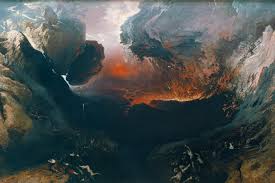Apocalyptic Literature

The book of Revelation is a genre that is very different from any other in the New Covenant. It is a unique blend of three distinct literary types: apocalypse, prophecy and letter. Furthermore, the basic type, apocalypse, is a literary form that does not exist today. We have a basic understanding of what an epistle or a narrative, a psalm, or a proverb is. But we simply have nothing quite like this. Therefore, it is especially important that we have a clear picture of the literary type we are dealing with.
The Revelation is primarily an apocalypse. The word apocalyptic comes from a Greek word apokalupsis. It is a noun and means an uncovering or revealing of the future. And although it is only one of the literary forms – it is a very special one, because there were dozens of apocalypses that were well known to both Jews and Christians from about 200 BC to AD 200. These other apocalypses, which are not part of the Bible, were all very different, yet they all, including Revelation, have some common characteristics.
1. The basis of apocalyptic is the prophetic literature of the TaNaKh, especially as it is found in Ezekiel, Dani’el and Zechariah, and parts of Isaiah. As is the case in some prophetic literature, apocalyptic was concerned about coming judgment and salvation. But apocalyptic was born either in persecution or in a time of great opposition. Therefore, its great concern was not the LORD’s activity within history. The apocalyptists looked exclusively toward the time when God would bring a violent, radical end to history. It would be an end that would mean the triumph of good and the final judgment of evil.
2. Unlike most of the prophetic books, apocalypses are literary works from the beginning. The prophets were basically spokesmen for ADONAI, whose spoken prophecies were later written down and collected in a book. But an apocalypse is a form of literature. It has a particular written structure and form. John, for example, was told to write what he had seen (1:19), whereas the prophets, for the most part, were commanded to speak what they were told.
3. Most frequently the stuff of apocalyptic is presented in the form of visions and dreams, and its language is cryptic (having hidden meanings) and symbolic. Therefore, most of the apocalypses contained literary devices that were intended to give the book a sense of antiquity. The most important of these devices was pseudonymity, that is, they were given the appearance of having been written by ancient fathers of the faith, who were told to seal it up for a later day. The later day, of course, being the age in which the book was then being written.
4. The images of apocalyptic are often forms of fantasy, rather than of reality. By way of contrast, the nonapocalyptic prophets and Jesus also regularly used symbolic language, but most often it involved real images. For example, they used salt (Matthew 5:13), vultures and carcasses (Luke 17:37), doves (Hosea 7:11), and half-baked cakes (Hosea 7:8), and so on. But most of the images of apocalyptic belong to fantasy, for example, a beast with seven heads and ten horns (13:1), a woman clothed with the sun (12:1), locusts with scorpions’ tails (9:10), and so on. The fantasy may not necessarily appear in the items themselves (we understand beasts, heads and horns), but in their unnatural combination.
5. Because they were literary, most of the apocalypses were very formally stylized. There was a strong tendency to divide time and events into nice, neat packages. There was also a great fondness for the symbolic use of numbers. In the case of the Bible, all impressed upon the human writer by the Holy Spirit without violating his own freedom to write. As a consequence, the book usually has the visions carefully strung together.
The Revelation of John fits all these characteristics of apocalyptic but one. And that one difference is so important that in some ways it becomes a world of its own. Revelation is not pseudonymous. Yochanan felt no need to follow the regular formula here. He made himself known to his readers and, through the seven letters in chapters 2 and 3, spoke to known churches in Asia Minor, who were contemporaries and companions in suffering. Moreover, he was told not to seal up the words of the prophecy of this book, because the time is near (22:10). What makes Yochanan so different than his earlier Jewish predecessors, is that he was not merely anticipating the end. He knew that it had already begun with the coming of Jesus Christ.
What makes John’s Apocalypse different is, first of all, its combination of apocalyptic and prophetic elements. On the other hand, the book is cast in the apocalyptic mold and has most of the literary characteristics of apocalyptic. It is born in persecution and intends to speak about the end with the triumph of Christ and His Bride. It is carefully constructed, using cryptic language and rich symbolism of fantasy and numbers.
On the other hand, John clearly intends this apocalypse to be a prophetic word to seven local churches. His book was not to be sealed for the future. It was a word from the LORD for their present situation. Prophecy does not primarily mean to foretell the future, but rather to speak forth God’s Word for the present, usually coming in judgment or salvation. In the Revelation, even the seven letters bear this prophetic imprint. Here then is God’s prophetic Word to seven local churches in the latter part of the first century who were undergoing persecution from without and decay from within.4



Leave A Comment